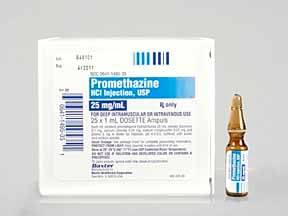
Promethazine Coupons & Savings Card – Discount Prices from $1.01
Generic for: Phenergan, Promethegan
My prescription
Edit
1ML of 25MG/ML, Promethazine (1 Ampule)
Select pharmacy

CVS
$20.18
COUPON PRICE
Walmart
$1.01
COUPON PRICE
Walgreens
$4.39
COUPON PRICE
Albertsons
$5.26
COUPON PRICEFree Promethazine Savings Card

Walmart
$1.01
Show this coupon to your pharmacist
ID
LH894228E7
PCN
CHIPPO
BIN
019876
GRP
LHX
This coupon is not insurance
Generic for: Phenergan, Promethegan
More prescriptions for skin allergy
More prescriptions for skin allergy
Price history for Promethegan (brand) & Promethazine (generic)
1 Ampule, 1ML of 25MG/ML
Average retail price for Promethegan
Average retail price for Promethazine
Average SaveHealth price for Promethazine
Our price history data is based on aggregated prescription data collected from participating pharmacies in America. Our prescription data updates daily to reflect the latest price changes. If you notice a missing data point, it means there wasn't sufficient data available to generate a monetary value for that date.
We analyzed Promethazine prices for (1ML of 25MG/ML, 1 Ampule) over the last 12 months. The average retail price was $14.99, while the average price using the SaveHealth discount card was $9.06. That's a savings of approximately 39.56% when using our Promethazine coupon.
Compared to the generic version, Promethegan had an average price of $228.39 over the same time period. With the SaveHealth savings card, Promethazine is 96.03% cheaper on average than Promethegan.
*Retail prices are based on pharmacy claims data, and may not be accurate when we don't have enough claims.
Promethazine dosage forms
Dosage Quantity Price from Per unit 1ML of 25MG/ML 1 Vial $1.01 $1.01 1ML of 25MG/ML 2 Vials $1.01 $0.51 1ML of 25MG/ML 3 Vials $1.01 $0.34 1ML of 50MG/ML 1 Vial $1.01 $1.01 1ML of 50MG/ML 2 Vials $1.01 $0.51 1ML of 50MG/ML 3 Vials $2.47 $0.82
| Dosage | Quantity | Price from | Per unit |
|---|---|---|---|
| 1ML of 25MG/ML | 1 Vial | $1.01 | $1.01 |
| 1ML of 25MG/ML | 2 Vials | $1.01 | $0.51 |
| 1ML of 25MG/ML | 3 Vials | $1.01 | $0.34 |
| 1ML of 50MG/ML | 1 Vial | $1.01 | $1.01 |
| 1ML of 50MG/ML | 2 Vials | $1.01 | $0.51 |
| 1ML of 50MG/ML | 3 Vials | $2.47 | $0.82 |
Promethazine Warnings
Promethazine is a medication that requires careful consideration due to its potential risks and safety concerns. Below are important safety details and precautions that must be reviewed before use:
Risks of Respiratory Depression: Promethazine can significantly slow down breathing, which can be life-threatening, especially in children under 2 years old or those with a history of respiratory issues. It is not recommended for children under 2. Seek immediate medical help if slow or shallow breathing occurs.
Injection Site Reactions: Serious tissue damage, including gangrene, can occur if promethazine is injected incorrectly, such as into an artery or under the skin. Always ensure the injection is administered into a muscle. Watch for burning, pain, redness, swelling, or skin discoloration at the injection site and seek medical attention if these occur.
Excessive Drowsiness: The medication can cause significant drowsiness, which may be worsened by alcohol consumption or use of other sedating drugs such as opioids or certain antidepressants. Avoid driving or operating machinery after taking promethazine.
Exacerbation of Existing Conditions: Promethazine may worsen certain medical conditions, including glaucoma, heart problems, enlarged prostate, breathing issues, bladder problems, stomach ulcers, and liver problems. Discuss your medical history with a healthcare provider before use.
Seizure Risk: Individuals with a history of seizures or those taking medications that lower the seizure threshold should use promethazine cautiously. Seek medical help if you experience symptoms like uncontrolled movements or confusion.
Risk of Infection: Promethazine can lower white blood cell counts, increasing infection risk, particularly in individuals undergoing chemotherapy. Notify your healthcare provider if you develop signs of infection, such as fever or chills.
Neuroleptic Malignant Syndrome (NMS): This rare condition can occur, especially when taken with antipsychotics. Symptoms include high fever, rapid heartbeat, stiff muscles, and confusion. Prompt medical attention is necessary if symptoms appear.
Involuntary Muscle Movements: Promethazine might cause uncontrollable muscle movements, particularly if taken with MAOIs or in sick, dehydrated children. Consult a healthcare provider if these symptoms develop.
Promethazine should not be used in certain cases, including in children under 2, individuals in a coma, those with lower respiratory tract issues such as asthma, those allergic to phenothiazines, or when an injection is administered into an artery or under the skin. Always consult a healthcare provider to ensure safe use of promethazine.
Promethazine Side Effects
Common side effects:
- drowsiness
- dizziness
- dry mouth
- constipation
- blurred vision
Less common but important to monitor:
- persistent sore throat
- fever
- chills
- loss of coordination
- fainting
- hallucinations
- restlessness
- trouble urinating
- slow heartbeat
- unusual body movements
- easy bruising
- severe stomach pain
- yellowing of the eyes or skin
Serious side effects:
- neuroleptic malignant syndrome (NMS)
- severe allergic reaction
Promethazine Interactions
Interactions with high risk of serious adverse effects and should be avoided:
- Bepridil
- Bromopride
- Calcium Oxybate
- Cisapride
- Dronedarone
- Magnesium Oxybate
- Mesoridazine
- Pimozide
- Piperaquine
- Potassium Oxybate
- Saquinavir
- Sodium Oxybate
- Sparfloxacin
- Terfenadine
- Thioridazine
- Tranylcypromine
- Ziprasidone
Interactions with moderate risk that may require dose adjustment, closer monitoring, or timing changes:
- Alfentanil
- Alprazolam
- Amiodarone
- Amisulpride
- Amitriptyline
- Amoxapine
- Anagrelide
- Apomorphine
- Aripiprazole
- Aripiprazole Lauroxil
- Arsenic Trioxide
- Asenapine
- Astemizole
- Azithromycin
- Benzhydrocodone
- Bromazepam
- Buprenorphine
- Bupropion
- Buserelin
- Butorphanol
- Cannabidiol
- Carbinoxamine
- Ceritinib
- Cetirizine
- Chloroquine
- Chlorpromazine
- Ciprofloxacin
- Citalopram
- Clarithromycin
- Clobazam
- Clofazimine
- Clomipramine
- Clozapine
- Codeine
- Crizotinib
- Dabrafenib
- Dasatinib
- Degarelix
- Delamanid
- Desipramine
- Deslorelin
- Deutetrabenazine
- Dihydrocodeine
- Disopyramide
- Dofetilide
- Dolasetron
- Domperidone
- Donepezil
- Doxylamine
- Droperidol
- Efavirenz
- Encorafenib
- Entrectinib
- Epinephrine
- Erythromycin
- Escitalopram
- Esketamine
- Fentanyl
- Fingolimod
- Flecainide
- Flibanserin
- Fluconazole
- Fluoxetine
- Formoterol
- Foscarnet
- Fostemsavir
- Gabapentin
- Gabapentin Enacarbil
- Gatifloxacin
- Gemifloxacin
- Glasdegib
- Glucagon
- Glycopyrrolate
- Glycopyrronium Tosylate
- Gonadorelin
- Goserelin
- Granisetron
- Halofantrine
- Haloperidol
- Histrelin
- Hydrocodone
- Hydromorphone
- Hydroxychloroquine
- Hydroxyzine
- Ibutilide
- Iloperidone
- Imipramine
- Inotuzumab Ozogamicin
- Isradipine
- Ivabradine
- Ivosidenib
- Ketamine
- Ketoconazole
- Lapatinib
- Lefamulin
- Lemborexant
- Lenvatinib
- Levocetirizine
- Levofloxacin
- Levorphanol
- Lithium
- Lofexidine
- Lopinavir
- Loxapine
- Lumefantrine
- Macimorelin
- Meclizine
- Mefloquine
- Meperidine
- Methacholine
- Methadone
- Metoclopramide
- Metrizamide
- Metronidazole
- Midazolam
- Mifepristone
- Mirtazapine
- Morphine
- Morphine Sulfate Liposome
- Moxifloxacin
- Nafarelin
- Nalbuphine
- Nilotinib
- Norfloxacin
- Nortriptyline
- Octreotide
- Ofloxacin
- Ondansetron
- Osilodrostat
- Osimertinib
- Oxaliplatin
- Oxycodone
- Oxymorphone
- Ozanimod
- Paliperidone
- Panobinostat
- Pasireotide
- Pazopanib
- Pentamidine
- Pentazocine
- Periciazine
- Pimavanserin
- Pitolisant
- Ponesimod
- Porfimer
- Posaconazole
- Pregabalin
- Procainamide
- Procarbazine
- Prochlorperazine
- Propafenone
- Protriptyline
- Quetiapine
- Quinine
- Ranolazine
- Remifentanil
- Remimazolam
- Revefenacin
- Ribociclib
- Scopolamine
- Secretin Human
- Selpercatinib
- Sertraline
- Sevoflurane
- Siponimod
- Sodium Phosphate
- Sodium Phosphate, Dibasic
- Sodium Phosphate, Monobasic
- Solifenacin
- Sorafenib
- Sotalol
- Sufentanil
- Sulpiride
- Sunitinib
- Tacrolimus
- Tapentadol
- Telavancin
- Telithromycin
- Tetrabenazine
- Tiotropium
- Toremifene
- Tramadol
- Trazodone
- Triclabendazole
- Trifluoperazine
- Trimipramine
- Triptorelin
- Vandetanib
- Vardenafil
- Vemurafenib
- Vinflunine
- Voclosporin
- Voriconazole
- Zolpidem
- Zuclopenthixol
Interactions with low risk that usually do not require a change in therapy:
- Aminolevulinic Acid
- Belladonna
- Belladonna Alkaloids
- Betel Nut
- Evening Primrose
- Midodrine
- Phenylalanine
